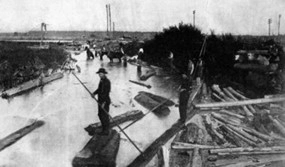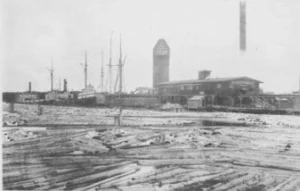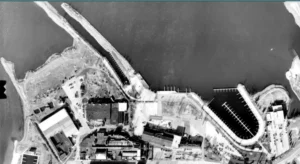History
“The best predictor of the future is history” – John Kenneth Galbraith
Adelaide Pointe’s campus has a rich and unique history of provisioning natural waterfront resources to create prosperity. Adelaide Pointe’s development plan pays homage to its history, never forgetting the footprints left by the boots of the men and women that worked on this historically important site.
 Adelaide Pointe was originally provisioned as a lumber mill in the 1870s and had the two largest docks on Muskegon Lake at nearly 1200’ long. The remnants of those docks became what are now Adelaide Pointe’s peninsula parks. Nearly a century and a half before the formation of Adelaide Pointe, Muskegon lumbermen walked to the end of those docks and saw the exact same waterfront views that can be seen today. Originally used to provide shelter for the many logs floated down the Muskegon River, these historical docks (now peninsulas) provide shelter for the Adelaide Pointe wet marina. The intense use of Adelaide Pointe’s site for lumber activities is what drove the inspiration for sustainable lumber-based construction in all of Adelaide’s buildings.
Adelaide Pointe was originally provisioned as a lumber mill in the 1870s and had the two largest docks on Muskegon Lake at nearly 1200’ long. The remnants of those docks became what are now Adelaide Pointe’s peninsula parks. Nearly a century and a half before the formation of Adelaide Pointe, Muskegon lumbermen walked to the end of those docks and saw the exact same waterfront views that can be seen today. Originally used to provide shelter for the many logs floated down the Muskegon River, these historical docks (now peninsulas) provide shelter for the Adelaide Pointe wet marina. The intense use of Adelaide Pointe’s site for lumber activities is what drove the inspiration for sustainable lumber-based construction in all of Adelaide’s buildings.
 The prosperity of the lumber era came to a close at the end of the 19th century, causing Muskegon to lose its status as one of the wealthiest areas in the United States. Muskegon entered a period of contraction, pessimism, skepticism and unemployment. Newspapers of the day bemoaned Muskegon’s fate claiming its surge of prosperity would never return. For nearly two decades that remained true.
The prosperity of the lumber era came to a close at the end of the 19th century, causing Muskegon to lose its status as one of the wealthiest areas in the United States. Muskegon entered a period of contraction, pessimism, skepticism and unemployment. Newspapers of the day bemoaned Muskegon’s fate claiming its surge of prosperity would never return. For nearly two decades that remained true.
In the early 1920s, William Hackley and the Hackley State Bank financed a loan that led to the formation of the Michigan Steel Company. After purchasing dirt on Adelaide Pointe’s South campus, Michigan Steel quickly constructed a brick building where foundry casting operations could take place. After achieving rapid success, Michigan Steel executives added a second story to that structure. In 2021 this structure was fully restored and converted to office space by Adelaide Pointe Management.
 During the 1930s Michigan Steel constructed an additional brick structure now called “Low West”. Within this structure, foundry operations expanded dramatically. As foundry sand was expended, it was dumped in the “back yard” of Adelaide Pointe’s site. This gradual dumping of sand fill began to encroach into Muskegon Lake.
During the 1930s Michigan Steel constructed an additional brick structure now called “Low West”. Within this structure, foundry operations expanded dramatically. As foundry sand was expended, it was dumped in the “back yard” of Adelaide Pointe’s site. This gradual dumping of sand fill began to encroach into Muskegon Lake.
During the 1940s Muskegon’s rapid foundry expansion led to Muskegon being labeled as one of the nation’s strategic industrial powerhouses. Thousands of tanks and millions of tons of steel parts were crafted and shipped all throughout the country as part of the war effort. Recruiting efforts were made across the country to bring in the workers necessary to support the massive levels of production the wartime effort required. Michigan Steel became one of the largest employers in Muskegon and renamed itself Westran Foundry. The name Westran can still be seen today as it is drawn in wet concrete by the finger of a Westran laborer
 During the 1950s, Westran’s operations expanded so dramatically that the sheer volume of sand dumped in the lake began to dramatically expand the size of its campus. Whereas the original historical lakefront was within 100 feet of the white brick building, throughout the 1950s and up until the mid-to-late 1960s the waterfront was slowly pushed backwards to where it is today. This is what created the northern Adelaide Pointe campus and its unique status as the only Lake Michigan-connected peninsula in Western Michigan.
During the 1950s, Westran’s operations expanded so dramatically that the sheer volume of sand dumped in the lake began to dramatically expand the size of its campus. Whereas the original historical lakefront was within 100 feet of the white brick building, throughout the 1950s and up until the mid-to-late 1960s the waterfront was slowly pushed backwards to where it is today. This is what created the northern Adelaide Pointe campus and its unique status as the only Lake Michigan-connected peninsula in Western Michigan.
By 1968 Westran was dumping so much fill into Muskegon Lake that Westran’s executives joked they were going to build a bridge to North Muskegon. The newly formed Environmental Protection Agency and the State of Michigan Natural Resources Commission filed suit against Westran to prevent them from dumping more fill into Muskegon Lake. Over the next decade Westran, the EPA, NRC, and U.S. Army Corp of Engineers engaged in a drawn-out court battle that ultimately led to the ending of all fill activities across Muskegon Lake. .

Over the next two decades, Muskegon suffered the fate of many rust-belt industrial towns as they struggled to compete with foreign dumping practices. One by one, the foundries of Muskegon Lake ceased operations. In the early 2000s, Vaughn Makary purchased the Adelaide Pointe property and did his best to continue employing the hundreds of Muskegon workers. Ultimately, those efforts failed, and the foundry cauldron burned bright for the last time in 2007. Local attorney Mr. David Bossenbroek assisted Mr. Makary in the shutting down of the entity.
Coincidentally enough, Bossenbroek (known affectionately amongst Adelaide Pointe staff as Uncle Dave) was neighbors with the Leestma family in the 90s, a family from Chicago who bought the house next door as a summer cottage. Over time, Uncle Dave became a trusted advisor for all members of the Leestma family. In late 2020, Bossenbroek informed Ryan of “The Most Beautiful Piece of Property in Muskegon” and the rest is now history in the making.

